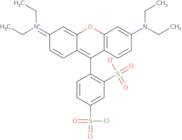Sulforhodamine B acid chloride
CAS: 62796-29-6
Ref. 3D-MCA79629
| 2g | Discontinued | ||
| 25mg | Discontinued | ||
| 50mg | Discontinued | ||
| 100mg | Discontinued | ||
| 250mg | Discontinued | ||
| 500mg | Discontinued |
Product Information
- Xanthylium, 9-[4-(chlorosulfonyl)-2-sulfophenyl]-3,6-bis(diethylamino)-, inner salt
- Xanthylium, 9-[4-(chlorosulfonyl)-2-sulfophenyl]-3,6-bis(diethylamino)-, hydroxide, inner salt
- Lissamine Rhodamine B sulfonyl chloride
- [9-[4-(Chlorosulfonyl)-2-sulfophenyl]-6-(diethylamino)-3H-xanthen-3-ylidene]diethylammonium hydroxide, inner salt
Sulforhodamine B acid chloride is a molecule with the chemical formula C 23 H 20 ClN 3 O 6 . This compound is used in analytical chemistry as a reagent for the determination of chloride content. Sulforhodamine B acid chloride reacts with organic compounds to yield an intense blue color. The intensity of the color depends on the concentration of chloride and the type of organic compound. It can be used to measure acidity in food or beverage samples, or as a probe for receptor binding in protein-ligand interactions. Sulforhodamine B acid chloride has been shown to react with tyrosine kinase domains and superparamagnetic iron oxide particles, which are widely used in magnetic separation techniques such as magnetic column chromatography, immunoaffinity chromatography, and immunoprecipitation. The detection sensitivity of sulforhodamine B acid chloride is comparable to that of other detection methods such as fluorescence microscopy, but it does not require expensive equipment or specialized training.





